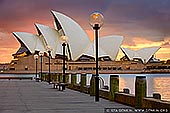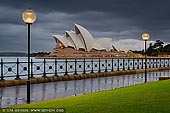Sydney Opera House
For a curated selection of my best images of the Sydney Opera House, Harbour Bridge, Circular Quay and The Rocks, visit the dedicated Sydney Harbour Wall Art Prints page. There you can explore panoramic skylines, dramatic sunrises, and colourful twilight scenes - all available as fine art prints and wall décor for home or office.
Related subjects: Sydney Harbour Bridge, Circular Quay and The Rocks, Darling Harbour, Transport in SydneyFor a curated selection of my best images of the Sydney Opera House, Harbour Bridge, Circular Quay and The Rocks, visit the dedicated Sydney Harbour Wall Art Prints page. There you can explore panoramic skylines, dramatic sunrises, and colourful twilight scenes - all available as fine art prints and wall décor for home or office.
Related subjects: Sydney Harbour Bridge, Circular Quay and The Rocks, Darling Harbour, Transport in SydneySydney Opera House must be one of the most recognisable images of the modern world - up there with the Eiffel Tower and the Empire State Building - and one of the most photographed. The Sydney Opera House has become, with the Sydney Harbour Bridge, Sydney's best-known landmark and international symbol.
The Sydney Opera House is a multi-venue performing arts centre in Sydney, New South Wales, Australia. It was conceived and largely built by Danish architect Jorn Utzon, who, in 2003, received the Pritzker Prize, architecture's highest honour. The Sydney Opera House was made a UNESCO World Heritage Site on 28 June 2007. It is one of the 20th century's most distinctive buildings and one of the most famous performing arts centres in the world.
The Sydney Opera House is situated on Bennelong Point in Sydney Harbour, close to the Sydney Harbour Bridge. It sits at the northeastern tip of the Sydney central business district (the CBD), surrounded on three sides by the harbour (Sydney Cove and Farm Cove) and neighboured by the Royal Botanic Gardens. The base for the building was started in 1959 - years before the designs were finished. It took four years to design by Danish architect Jorn Utzon and by 1962 the designs were finalized and construction began. In total it took 14 years to build and was officially opened on the 20th of October 1973 by Queen Elizabeth II. The Sydney Opera House cost some $160 million to build and was paid for by the public who bought $10 tickets in a series of lotteries with a first prize of $1 million. Utzon became involved in a massive political row with the government and left before the building was finished.
The Sydney Opera House is nonetheless a fascinating building and heart of the city's cultural scene. It opened with a concert hall, an opera theatre, a drama theatre and a recital hall, as well as restaurants and bars. A fifth theatre was added within the structure in 1998. The building also houses a recording studio, cafes, restaurants and bars and retail outlets. Guided tours are available to the public, including a frequent tour of the front-of-house spaces, and a daily backstage tour which takes visitors backstage to see areas normally reserved for performers and crew members.
Planning to photograph these locations yourself? Whether you're a serious photographer or just visiting with a camera in hand and have a short time in the city, check out my 12 Best Photography Spots for Classical Sydney Skyline Guide and 10 Sydney's Best Sunrise Photography Locations Guide for the best times, tips, and spots to shoot. The guide covers the best viewpoints, lighting conditions, and shooting tips to help you make the most of your time.
About the Artist
I'm Ilya Genkin - an internationally recognised Australian landscape and fine art photographer offering wall art prints. My passion for capturing the beauty of nature and our world translates into striking photographic prints that bring life, emotion, and inspiration to any space. From tranquil seascapes to dramatic mountainscapes, each image is a reflection of my vision and dedication to the art of photography.
Read more about Ilya Genkin and shop fine art prints online from his collection.
Wall Art Prints Featuring Fine Art Landscape Photography
Explore my extensive collection of wall art prints - crafted with the highest-quality materials to suit every style and budget. Whether you're looking for a luxurious, ready-to-hang piece or a beautifully printed work to frame yourself, each photograph is available in several premium formats: Gallery-quality Fine Art Paper Prints - ready for framing, and Professional Canvas Prints - classic and timeless texture.
Each artwork is meticulously printed and made-to-order to ensure you receive a piece that elevates your home, office, or commercial space. Buy fine art prints online to suit your style.
Artworks for Interior Designers, Home Stylists, and Architects
I collaborate with interior designers, home stylists, and architects to create bespoke wall art prints tailored to your project's aesthetic, colour palette and interior design needs. Prints can be customised and sized to complement your space perfectly. All pieces are made-to-order, and pricing varies based on size, quantity, and shipping.
Contact me to discuss your project and request a personalised quote.
Why Choose Ilya Genkin Photography?
By choosing my work, you're not just acquiring exceptional art - you're supporting an independent Australian artist and contributing to a vibrant local creative community. Every purchase directly helps sustain and grow this craft, bringing authentic and meaningful art into your life.
Request a free mockup to see how a chosen photograph will look in your space before you buy.
Start your journey today - shop our wall art collection, purchase with confidence, or order custom prints today and transform your walls with fine art photography.
Fine Art Landscape Photography
Information
Photography Guides
Online Store Opens 24/7
Email:
Phone: +61 (0) 421 055 613
Crafted with care for the planet - using sustainable materials and eco-friendly packaging.
Ilya Genkin Photography acknowledges the Traditional Custodians of the land on which we operate, live and gather as employees, and recognise their continuing connection to land, water and community. We pay respect to Elders past, present and emerging.



















































